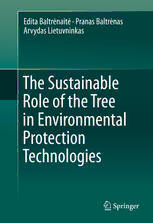Table Of ContentEdita Baltrėnaitė · Pranas Baltrėnas
Arvydas Lietuvninkas
The Sustainable
Role of the Tree
in Environmental
Protection
Technologies
The Sustainable Role of the Tree in Environmental
Protection Technologies
Edita Baltre˙naite˙ • Pranas Baltre˙nas
Arvydas Lietuvninkas
The Sustainable Role of the
Tree in Environmental
Protection Technologies
EditaBaltre˙naite˙ PranasBaltre˙nas
DepartmentofEnvironmentalProtect VilniusGediminasTechnicalUniversity
VilniusGediminasTechnicalUniversity Vilnius,Lithuania
Vilnius,Lithuania
ArvydasLietuvninkas
VilniusGediminasTechnicalUniversity
Vilnius,Lithuania
ISBN978-3-319-25475-3 ISBN978-3-319-25477-7 (eBook)
DOI10.1007/978-3-319-25477-7
LibraryofCongressControlNumber:2015956777
SpringerChamHeidelbergNewYorkDordrechtLondon
©SpringerInternationalPublishingSwitzerland2016
Thisworkissubjecttocopyright.AllrightsarereservedbythePublisher,whetherthewholeorpartof
the material is concerned, specifically the rights of translation, reprinting, reuse of illustrations,
recitation, broadcasting, reproduction on microfilms or in any other physical way, and transmission
or information storage and retrieval, electronic adaptation, computer software, or by similar or
dissimilarmethodologynowknownorhereafterdeveloped.
The use of general descriptive names, registered names, trademarks, service marks, etc. in this
publicationdoesnotimply,evenintheabsenceofaspecificstatement,thatsuchnamesareexempt
fromtherelevantprotectivelawsandregulationsandthereforefreeforgeneraluse.
Thepublisher,theauthorsandtheeditorsaresafetoassumethattheadviceandinformationinthis
book are believed to be true and accurate at the date of publication. Neither the publisher nor the
authors or the editors give a warranty, express or implied, with respect to the material contained
hereinorforanyerrorsoromissionsthatmayhavebeenmade.
Printedonacid-freepaper
Springer International Publishing AG Switzerland is part of Springer Science+Business Media
(www.springer.com)
For Lithuania and its people
Preface
Changes in Earth’s biosphere as civilization has developed, its increased
technogenic load, and reduced overall resources of resistant stability spur the
natural and technological sciences to properly concentrate on the possibilities of
interactionbetweensustainablehumanactivityandnaturalecosystems.Treesarea
primaryfocus.Naturaltreeecosystems(forests),intermsoftheoverallmassofthe
biosphere, have been devastated, in the majority of cases by human activity.
Humans also have intensively utilized the energetic, biological, and recreational
resourcesoftreesthroughouttheirlifecycles.Theinvolvementofindustrialsociety
in large-scale applications of fossil fuels along with the rapid development of
industry has resulted in the urgent current issue of widespread pollution of the
ecosphereandthethreatofglobalwarming.
The use of trees in ecological technologies is based on their unquestioned
importance in maintaining stability in the biosphere as well as on their presence
inanumberofEarth’sbiomesanditsecosystems,particularlythoseofScotspine
growing in urbanized territories and zones affected by pollution sources. This
aspect in particular creates favorable conditions for using trees as bioindicators
forestablishingthepropertiesandlevelsofcontaminationand,insomecases,asa
measure for reducing pollution. Because the consequences of negative changes
occurringinnaturecanonlybeminimizedoncetheiressentialcharacterisunder-
stood,thisbookfocusesmainlyontreesasbiogeochemicalobjectsanddiscussesa
mechanismbywhichheavymetalsenterintotrees,theimpactofbioticstressorsas
determinants of entry, the specificity of metal accumulation in certain species of
trees and their parts, the biophilicity of heavy metals, and other aspects of
biogeochemistry.
Consideringtheextentofthelifecycleofthetreeandwithrespecttowoodasan
industrialmaterialand anagent for the sequestration ofatmospheric carbon diox-
ide,investigationsintothermallytreatedwoodproductsandtheefficiencyoftheir
application in the field of environmental protection engineering are presented.
Greater focus is shiftedtothe properties ofbiochar and todefining itsadvantages
asapackingmaterialofthefilters.
vii
viii Preface
Exhaustive treatment of the versatile role of trees in environmental protection
technologiesishardlypossiblewithoutspecificallyappliedresearchmethods.Thus,
investigationintoheavymetalconcentrationsandtheirdistributionintreeringshas
assistedinadvancingtechnologyforwoodsamplingandevaluatingtheirrepresen-
tiveness. To assess the eco-technological aspect of using trees in environmental
protectiontechnologies,amethodofdynamicfactorsthatmaximizestheelimina-
tion of the impact of local environmental geochemical features on the element
uptake evaluation has been developed. As an effective method for examining
variousecologicalaspects,amathematicalsimulationoftheprocessesofcontam-
inanttransportintheenvironment,includingtheoriginalmodelsdevelopedbythe
authorsofthebook,hasbeenapplied.
The novelty of the book is its explication of the sustainable role of the tree in
environmental protection technologies, and the book includes reviews, research,
andanevaluationoftheuseoftrees.
This publication is dedicated to scientists and experts in the field of environ-
mentalprotection.Would-bescientists–Ph.D.andM.A.students–mayrefertothe
study as a source of scientific knowledge in the field of environmental protection
technologies.
Reviewers
Prof.Dr.HabilIrenaEitminavicˇi(cid:1)ute˙,Vilnius,Lithuania.
Dr.Ar(cid:1)unasDraugelis,Chicago,UnitedStatedofAmerica.
Prof.Dr.HabilPetrasVaitiek(cid:1)unas,Vilnius,Lithuania.
Vilnius,Lithuania EditaBaltre˙naite˙
2016 PranasBaltre˙nas
ArvydasLietuvninkas
Contents
1 TheTreeinEarth’sTerrestrialEcosystems. . . . . . . . . . . . . . . . . . . 1
1.1 FunctionsoftheTreeintheBiogeochemicalCycle
ofMaterials. . . . . . . . . . . . . . . . . . . . . . . . . . . . . . . . . . . . . . . . 2
TheCarbonCycle. . . . . . . . . . . . . . . . . . . . . . . . . . . . . . . . . . . 2
ForestsintheEcosphere. . . . . . . . . . . . . . . . . . . . . . . . . . . . . . . 7
ForestsintheEuropeanUnionandLithuania. . . . . . . . . . . . . . . . 11
1.2 LifeCycleoftheTree. . . . . . . . . . . . . . . . . . . . . . . . . . . . . . . . 14
1.3 BenefitsoftheTreeinEnvironmentalProtectionTechnologies. . . 22
2 ContaminationFeaturesofEcosystemComponents
inaForestedSurroundingEnvironment. . . . . . . . . . . . . . . . . . . . . 29
2.1 EdaphicContaminationandItsEcogeologicalEvaluation. . . . . . . 30
SoilContaminationbyMetalsinLithuania
andItsRiskAssessment. . . . . . . . . . . . . . . . . . . . . . . . . . . . . . . 35
2.2 Aqueous(SurfaceRunoffWater)Contamination
PatternsinUrbanAreas. . . . . . . . . . . . . . . . . . . . . . . . . . . . . . . 42
ChemicalPropertiesofSurfaceRunoffWater. . . . . . . . . . . . . . . 45
AssessmentofMetalSpeciationinSRWUsing
WindermereHumicAqueousModel. . . . . . . . . . . . . . . . . . . . . . 51
2.3 AerogenicContaminationandItsEvaluation
onEcosystem-BasedApproach. . . . . . . . . . . . . . . . . . . . . . . . . . 54
RoleofDepositMediainEcosystemswiththeLoad
ofAerogenicContaminants. . . . . . . . . . . . . . . . . . . . . . . . . . . . . 54
PrinciplesofDepositMediaAnalysis:
AnalysisStrategy,MethodsofPhysical
andChemicalAnalysis. . . . . . . . . . . . . . . . . . . . . . . . . . . . . . . . 56
EvaluatingthePollutionofDepositMedia. . . . . . . . . . . . . . . . . . 59
UseofDepositMediaforEvaluatingLevel
ofEcosystemContamination. . . . . . . . . . . . . . . . . . . . . . . . . . . . 62
ix

